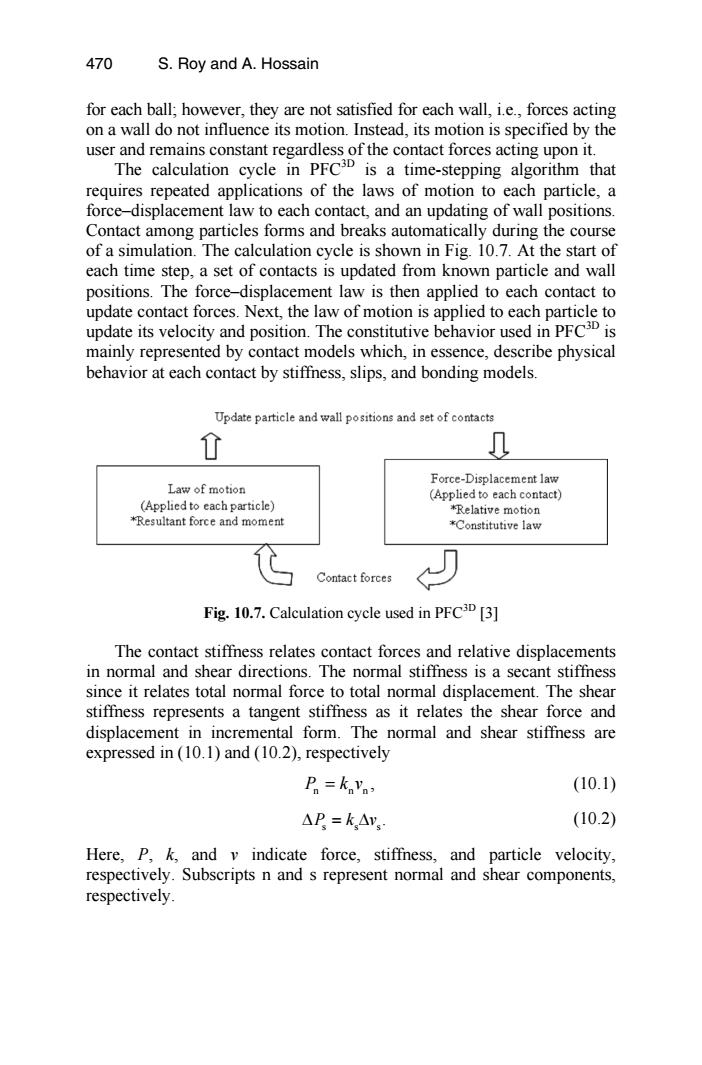正在加载图片...

470 S.Roy and A.Hossain for each ball;however,they are not satisfied for each wall,i.e.,forces acting on a wall do not influence its motion.Instead,its motion is specified by the user and remains constant regardless of the contact forces acting upon it. The calculation cycle in PFC3D is a time-stepping algorithm that requires repeated applications of the laws of motion to each particle,a force-displacement law to each contact,and an updating of wall positions. Contact among particles forms and breaks automatically during the course of a simulation.The calculation cycle is shown in Fig.10.7.At the start of each time step,a set of contacts is updated from known particle and wall positions.The force-displacement law is then applied to each contact to update contact forces.Next,the law of motion is applied to each particle to update its velocity and position.The constitutive behavior used in PFC3D is mainly represented by contact models which,in essence,describe physical behavior at each contact by stiffness,slips,and bonding models. Update particle and wall positions and set of contacts Force-Displacement law Law of motion (Applied to each contact) (Applied to each particle) *Relative motion *Resultant force and moment *Constitutive law Contact forces Fig.10.7.Calculation cycle used in PFC3D The contact stiffness relates contact forces and relative displacements in normal and shear directions.The normal stiffness is a secant stiffness since it relates total normal force to total normal displacement.The shear stiffness represents a tangent stiffness as it relates the shear force and displacement in incremental form.The normal and shear stiffness are expressed in(10.1)and (10.2),respectively P=kovo? (10.1) △P=kAy (10.2) Here,P,k,and v indicate force,stiffness,and particle velocity, respectively.Subscripts n and s represent normal and shear components, respectively.for each ball; however, they are not satisfied for each wall, i.e., forces acting on a wall do not influence its motion. Instead, its motion is specified by the user and remains constant regardless of the contact forces acting upon it. The calculation cycle in PFC3D is a time-stepping algorithm that requires repeated applications of the laws of motion to each particle, a force–displacement law to each contact, and an updating of wall positions. Contact among particles forms and breaks automatically during the course of a simulation. The calculation cycle is shown in Fig. 10.7. At the start of each time step, a set of contacts is updated from known particle and wall positions. The force–displacement law is then applied to each contact to update contact forces. Next, the law of motion is applied to each particle to update its velocity and position. The constitutive behavior used in PFC3D is mainly represented by contact models which, in essence, describe physical behavior at each contact by stiffness, slips, and bonding models. Fig. 10.7. Calculation cycle used in PFC3D [3] The contact stiffness relates contact forces and relative displacements in normal and shear directions. The normal stiffness is a secant stiffness since it relates total normal force to total normal displacement. The shear stiffness represents a tangent stiffness as it relates the shear force and displacement in incremental form. The normal and shear stiffness are expressed in (10.1) and (10.2), respectively n nn P = k v , (10.1) s ss P kv = . (10.2) Here, P, k, and v indicate force, stiffness, and particle velocity, respectively. Subscripts n and s represent normal and shear components, respectively. S. Roy and A. Hossain ∆ ∆ 470